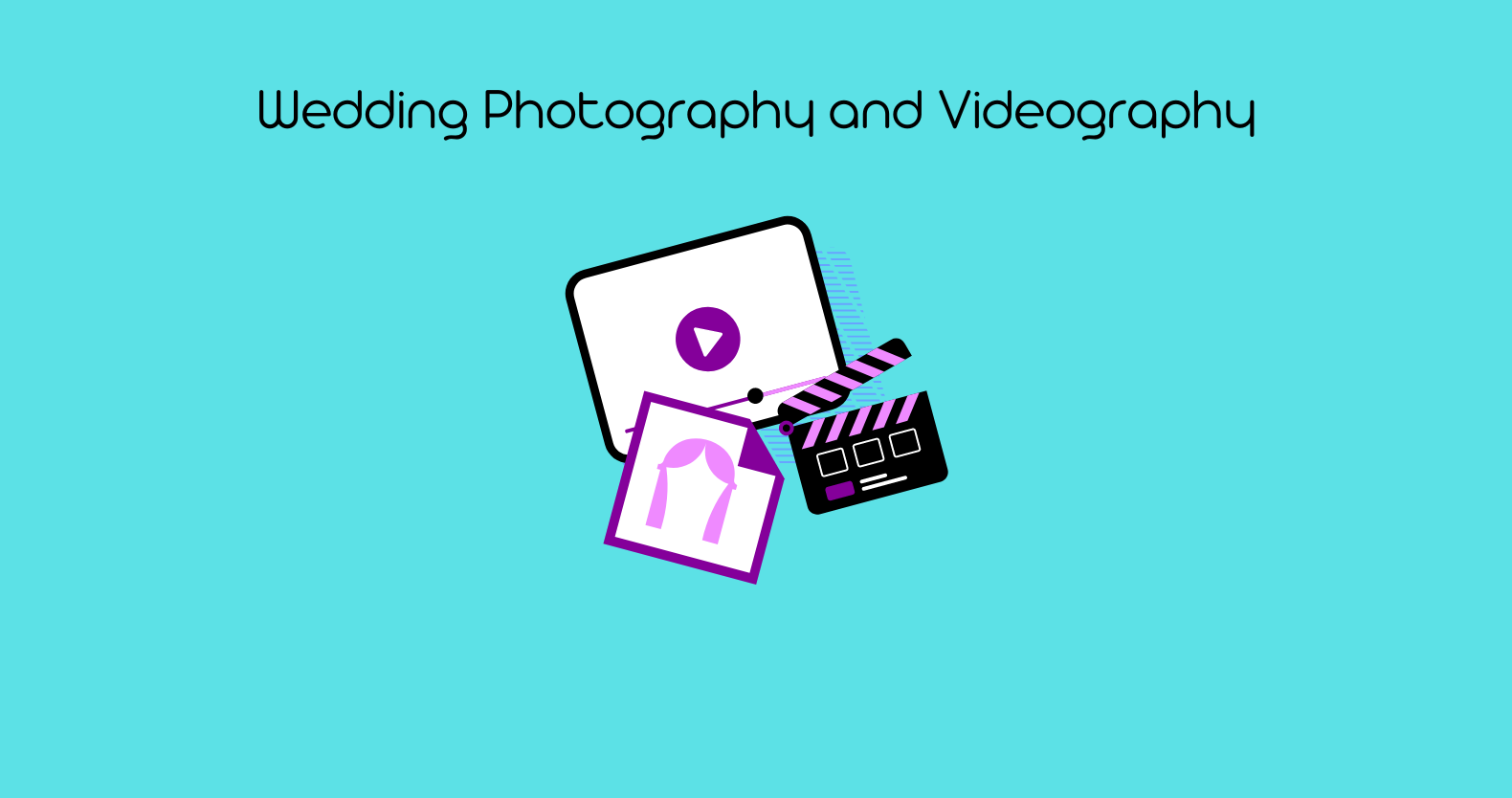Table Of Content
Wedding Photography Checklist for Couples
Things to Consider for Wedding Photography & Videography
Photography Tips For Stunning Wedding Photos
1. Understanding Light and Its Impact
2. Mastering Composition and Framing
3. Capturing Candid Moments
4. Choosing the Right Gear
5. Creating a Shot List
6. Engaging with the Couple and Guests
7. Post-Processing and Editing
8. Capturing the Details
9. Handling Different Weather Conditions
10. Practicing Patience and Timing
How to Film A Wedding?
Rav.ai and Wedding Video Editing
Final Thoughts!
When planning a wedding, photography and videography play a crucial role in capturing the magic of your big day.
In fact, statistics show that couples spend an average of 10-15% of their wedding budget on photography and videography, highlighting the importance of these services.
This comprehensive guide will cover everything you need to know, from creating a wedding photography checklist to ensuring stunning wedding photos.
We’ll also discuss key considerations for both photography and videography, offer expert tips for capturing beautiful moments, and provide insights into how to film a wedding like a pro.
Wedding Photography Checklist for Couples
1. Discuss Your Vision with Your Photographer
Before the wedding day, sit down with your photographer to discuss your vision. This includes the style of photography you prefer, such as traditional, candid, or photojournalistic.
Explain the moments that are most important to you, whether it’s the first look, candid shots of guests, or detailed images of your wedding décor.
Communication is key to ensuring that your photographer understands your expectations and can capture the day exactly as you envision.
Providing examples from other weddings can help your photographer grasp your style preferences, ensuring your wedding album reflects your personality.
2. Create a Detailed Shot List
A shot list is a crucial tool for ensuring no moment is missed on your wedding day. Work with your photographer to create a list of must-have shots, including family portraits, key ceremony moments, and detailed shots of rings, invitations, and décor.
This list should also include any special requests, such as photos with friends or specific locations at the venue. While photographers are professionals at capturing the flow of the day, a shot list helps ensure that the specific images you want are not overlooked, providing peace of mind on your big day.
3. Plan for Getting Ready Photos
The “getting ready” part of the day offers some of the most intimate and emotional photo opportunities. Plan ahead by ensuring your getting-ready location is well-lit, spacious, and free of clutter.
Discuss with your photographer which moments you’d like captured, such as the bride’s dress hanging up, the makeup process, or a toast with your bridesmaids.
The groom’s preparations are equally important, from tying his tie to candid moments with his groomsmen. These shots add depth to your wedding album, capturing the anticipation and excitement leading up to the ceremony.
4. First Look vs. Traditional First Look
Deciding between a first look before the ceremony or seeing each other for the first time at the altar is an important choice. A first look offers a private moment for just the two of you, often resulting in genuine, emotional photos.
This also allows for more time to take a couple of portraits before the ceremony. On the other hand, a traditional first look captures the raw emotions of seeing each other for the first time as you walk down the aisle, often with the added joy of sharing that moment with your guests. Discuss the pros and cons with your partner and photographer to decide which is best for you.
5. Consider the Lighting Throughout the Day
Lighting plays a critical role in wedding photography, affecting the quality and mood of your photos. Natural light is often preferred, so consider the time of day when scheduling your ceremony and portraits. For example, the “golden hour” just before sunset offers soft, warm light ideal for romantic portraits.
If your ceremony or reception is indoors, discuss the venue’s lighting with your photographer to plan for any additional lighting equipment that might be needed. Ensuring good lighting will help your photographer capture the best possible images, no matter the time or location.
6. Family and Group Photos
Organizing family and group photos can be one of the more challenging parts of wedding photography, but planning ahead makes it smoother. Provide your photographer with a list of the specific groupings you want, such as immediate family, extended family, and bridal party.
Assign a member of the bridal party to help gather people and keep the process moving quickly. It’s also a good idea to decide on a specific location for these photos, ideally one that is easily accessible and has good lighting. Efficiently managing these group shots ensures everyone is included, and you can get back to enjoying your day.
7. Capture the Ceremony Details
The ceremony is the heart of your wedding day, and capturing its details is essential. Discuss with your photographer the specific moments you want to be photographed, such as the exchange of vows, rings, and the first kiss. Don’t forget the smaller details, like the ceremony programs, floral arrangements, and the altar setup.
If your ceremony includes unique elements, such as cultural traditions or special readings, make sure your photographer is aware so they can capture these moments. Detailed shots of the ceremony help tell the full story of your day and preserve the memories of this significant part of your wedding.
8. Reception Highlights
The reception is a time for celebration, and your photographer should capture the energy and joy of the event. Key moments to include are the first dance, speeches, cake cutting, and bouquet toss.
Additionally, candid shots of guests enjoying themselves, as well as the décor and any special entertainment or surprises, should also be captured. Consider having a second photographer or videographer to ensure all angles and moments are covered, especially if your reception has a large guest list. These photos will reflect the fun and festivities of your wedding day, rounding out your wedding album.
9. Consider an Engagement Session
An engagement photo session is a great way to get comfortable in front of the camera before your wedding day. It allows you to build a rapport with your photographer and gives you a chance to experiment with poses and styles.
Engagement photos can also be used for save-the-dates, invitations, or wedding websites. This session helps your photographer understand how you interact as a couple, leading to more natural and authentic photos on your wedding day. Plus, it’s an opportunity to capture beautiful images of you and your partner in a more relaxed setting.
10. Post-Wedding Photo Review and Album Creation
After the wedding, schedule a time to review your photos with your photographer. This is your chance to select your favorite images for your wedding album and any prints you want. Discuss the design and layout of your album, including any specific requests for photo placement or captions.
Consider creating a timeline or storybook format that reflects the flow of your day. An organized and thoughtful review process ensures your wedding album is a cherished keepsake that tells the story of your day in the most beautiful way possible.
Things to Consider for Wedding Photography & Videography
1. Understanding Your Style Preferences
One of the first things to consider when planning wedding photography and videography is your style preference. Do you prefer a traditional, classic look, or are you more inclined towards a candid, documentary style?
Perhaps you love the idea of a modern, edgy aesthetic or a romantic, fine art approach. Knowing your style will help you choose the right photographer and videographer who specializes in that particular aesthetic.
Discuss these preferences with your partner and browse portfolios online to see what resonates with you. This step ensures that the final product aligns with your vision for your wedding day memories.
2. Setting a Realistic Budget
Photography and videography are significant aspects of your wedding, and they often require a substantial portion of your budget. It’s crucial to set a realistic budget early on to avoid any surprises later.
Prices can vary widely depending on the photographer’s or videographer’s experience, the number of hours needed, and whether you want additional services like albums, prints, or highlight reels. Consider what is most important to you and allocate your budget accordingly. Remember that these are your memories being captured, so investing in quality is often worth the extra cost.
3. Researching and Booking Professionals Early
Top photographers and videographers are often booked months, if not years, in advance, especially during peak wedding seasons. Once you’ve set your budget and determined your preferred style, start researching professionals in your area.
Look at their portfolios, read reviews, and consider meeting with a few before making a decision. Booking early not only ensures you get the photographer or videographer you want, but it also allows for ample time to discuss and plan the specific shots and moments you want to be captured. Early booking is key to securing your top choice.
4. Creating a Detailed Shot List
A shot list is essential for ensuring that all the important moments of your wedding day are captured. This list should include must-have shots, such as the first look, the exchange of rings, and family portraits, as well as any special requests, like specific locations or poses.
Work with your photographer and videographer to develop this list and make sure it’s comprehensive. Having a shot list helps the professionals stay organized and ensures that no significant moment is missed. It’s a way to communicate your expectations clearly and make sure they are met.
5. Considering the Venue’s Lighting and Space
The lighting and space at your wedding venue play a crucial role in the quality of your photos and videos. Natural light is often ideal, but if your venue is indoors or the ceremony is at night, additional lighting may be necessary. Discuss the venue’s lighting conditions with your photographer and videographer during a walkthrough if possible.
They may suggest bringing in extra lighting equipment or using certain techniques to ensure the best results. Additionally, consider the space available for capturing moments; crowded or cramped spaces might limit the angles and shots your team can achieve.
6. Scheduling Enough Time for Photos and Videos
Time management on your wedding day is crucial, particularly when it comes to photography and videography. Ensure that your schedule allows enough time for all the essential shots without feeling rushed. For instance, plan extra time to get ready photos, first look moments, and group portraits.
Discuss your timeline with your photographer and videographer ahead of time to ensure they have enough time to capture each moment. A well-planned schedule helps everything run smoothly and reduces stress, allowing you to enjoy your day knowing that all the key moments will be beautifully documented.
7. Discussing Post-Production Expectations
Post-production is a significant part of the photography and videography process, involving editing, color correction, and sometimes even retouching.
It’s important to discuss your expectations for post-production with your photographer and videographer. Do you want a lot of editing, or do you prefer a more natural look?
What about black-and-white photos or special effects in your video?
Understanding the post-production process and timelines will help manage your expectations and ensure you are satisfied with the final product. Be sure to ask about how long it will take to receive your photos and videos.
8. Including Backup Plans for Equipment and Weather
Weddings are live events, and sometimes, things don’t go as planned. Equipment failure or unexpected weather changes can affect your photography and videography. Discuss backup plans with your professionals. Do they have backup cameras and lenses? What if it rains during an outdoor ceremony?
It’s important to know that your photographer and videographer are prepared for any situation. This might include having a covered area for photos or being prepared to shoot indoors if necessary. Knowing that there’s a plan B gives you peace of mind that your day will be captured no matter what.
9. Reviewing the Contract Thoroughly
Before signing a contract with your photographer or videographer, make sure you review it thoroughly.
The contract should outline all the services provided, including the number of hours of coverage, the number of edited photos, video length, and any additional services like albums or prints. It should also cover the payment schedule, cancellation policies, and what happens in case of emergencies.
A clear contract protects both you and the professional, ensuring that everyone is on the same page regarding what is expected. Don’t hesitate to ask questions or request changes before signing.
10. Planning for Engagement or Pre-Wedding Shoots
An engagement or pre-wedding shoot is a great opportunity to get comfortable in front of the camera before your big day. It allows you to build a rapport with your photographer and videographer and experiment with different poses and settings.
These shoots can also provide you with beautiful images to use for save-the-dates, wedding websites, or even as décor on your wedding day.
Discuss the location, outfits, and overall theme of the shoot with your photographer to ensure it aligns with your wedding vision. These sessions are a fun way to document your journey to the altar and add another layer to your wedding memories.
Photography Tips For Stunning Wedding Photos
1. Understanding Light and Its Impact
Lighting is one of the most critical aspects of photography, especially for weddings. Natural light can create beautiful, soft images, while artificial light can add drama and intensity to photos. The key is to understand how light interacts with your subject and environment.
For example, shooting during the “golden hour”—the hour just after sunrise or before sunset—can give your photos a warm, soft glow that’s highly flattering. Conversely, harsh midday sunlight can create unflattering shadows, so knowing how to use diffusers or reflectors can help soften the light. Experimenting with backlighting, where the light source is behind the subject, can also create stunning silhouettes and add depth to your photos.
2. Mastering Composition and Framing
Composition refers to how elements are arranged within a photo, and framing is the technique of drawing attention to the subject by blocking parts of the image. Both are essential for creating visually appealing wedding photos. Using the rule of thirds, where the subject is placed off-center, can create a more dynamic image.
Leading lines, such as pathways or architectural elements, can guide the viewer’s eye toward the subject. Symmetry and patterns can also add balance and harmony to your composition.
Don’t forget about the background; a cluttered or distracting background can detract from the subject, so always be mindful of what’s behind your couple.
3. Capturing Candid Moments
While posed photos are essential, candid moments often tell a more authentic story. Capturing the genuine emotions of the day, such as a bride’s laughter or a groom’s tearful glance, can create powerful, memorable images. To capture these moments, be unobtrusive and always ready with your camera.
Use a longer lens to shoot from a distance, allowing your subjects to be themselves without feeling the pressure of being photographed. Anticipating moments, like a father seeing his daughter in her wedding dress for the first time, will enable you to capture raw, unfiltered emotions that truly reflect the spirit of the day.
4. Choosing the Right Gear
Having the right equipment can make a significant difference in the quality of your wedding photos. A good DSLR or mirrorless camera with a range of lenses, including a fast prime lens for low-light situations and a zoom lens for capturing distant moments, is essential. Additionally, having backup equipment is crucial in case of technical failures.
Accessories like external flashes, reflectors, and tripods can also help in different shooting scenarios. Moreover, consider carrying extra batteries and memory cards to ensure you don’t miss any crucial moments. The right gear not only improves image quality but also enhances your ability to work efficiently.
5. Creating a Shot List
A shot list is a checklist of all the essential photos you want to capture during the wedding day. This includes standard shots like the bride and groom’s first kiss, family portraits, and the exchange of rings.
But it’s also important to personalize the list to include special moments or details that are unique to the couple, such as heirloom items or cultural traditions. Discussing the shot list with the couple beforehand ensures that you understand their priorities and expectations. A well-prepared shot list helps you stay organized and ensures that no important moments are missed during the chaos of the day.
6. Engaging with the Couple and Guests
Building rapport with the couple and their guests can lead to more relaxed, natural photos. When people feel comfortable around you, they are more likely to act naturally, resulting in candid, genuine images.
Take the time to get to know the couple before the wedding day, and communicate with them throughout the event to ensure you’re capturing their vision. Being friendly and approachable with guests also helps in getting them to participate in group photos or allowing you to capture candid moments. Your ability to connect with people will reflect in the warmth and authenticity of your images.
7. Post-Processing and Editing
Post-processing is where your photos come to life. Editing allows you to correct any exposure issues, enhance colors, and add artistic touches to your images. However, it’s important not to overdo it. The goal is to enhance the photo while maintaining its natural look. Programs like Adobe Lightroom and Photoshop are popular for editing wedding photos.
Consider creating a consistent style or filter that you apply across the wedding gallery to give the photos a cohesive look. Post-processing is also the time to crop and straighten images, remove any distractions, and ensure that the final product is polished and professional.
8. Capturing the Details
Weddings are filled with beautiful details, from the bride’s bouquet to the intricate designs on the cake. Capturing these details not only adds variety to your wedding gallery but also helps tell the story of the day. Use a macro lens to get close-up shots of small items like rings, jewelry, and floral arrangements.
Pay attention to the decor, table settings, and any personalized elements that the couple has incorporated into their wedding. These detailed shots add depth to the wedding album and allow the couple to remember all the little things that made their day special.
9. Handling Different Weather Conditions
Weather is unpredictable, and being prepared for all conditions is key to successful wedding photography. Rain, for instance, can create romantic, moody photos, but it requires waterproof gear and possibly an umbrella for the couple. Bright, sunny days may require the use of reflectors or diffusers to soften harsh shadows.
Overcast skies, on the other hand, can provide soft, even lighting that is ideal for portraits. Whatever the weather, having a plan in place will help you adapt and continue capturing beautiful photos. Flexibility and creativity are your best tools when dealing with the ever-changing elements.
10. Practicing Patience and Timing
Weddings can be chaotic, and things don’t always go as planned. Practicing patience and having a good sense of timing are crucial. Sometimes, the best moments come when you least expect them, so always be ready with your camera.
Whether it’s a spontaneous dance move on the floor or a quiet moment between the bride and groom, being patient and observant will help you capture those fleeting, magical moments. Additionally, understanding the flow of the wedding day and knowing when to anticipate certain events will ensure you’re in the right place at the right time to get the perfect shot.
How to Film A Wedding?
1. Plan the Wedding Day Schedule
Before you start filming, it’s essential to have a detailed schedule of the wedding day. This includes knowing the time and location of each event, from the bride’s preparation to the reception.
Understanding the flow of the day allows you to be in the right place at the right time, ensuring you capture all the key moments.
Coordinate with the wedding planner and the couple to ensure you’re aware of any special events or surprises. Having a clear timeline helps you plan your shots and ensures that you don’t miss any important moments.
2. Scout the Venue
Visit the wedding venue before the big day to familiarize yourself with the location. This helps you plan your shots and identify the best spots for filming. Check the lighting conditions, as this will affect your camera settings. Look for scenic backgrounds, quiet areas for interviews, and spots with natural light.
Scouting the venue also allows you to identify potential challenges, such as crowded spaces or tricky angles, so you can plan how to work around them. Knowing the layout of the venue will help you move quickly and efficiently on the wedding day.
3. Choose the Right Gear
The right equipment is crucial for filming a wedding. A high-quality camera with good low-light performance is essential, as weddings often take place in dimly lit venues. Lenses with a wide aperture are great for capturing beautiful bokeh and performing well in low light. Don’t forget to bring a stabilizer or tripod to keep your shots steady, especially during the ceremony.
Additionally, having an external microphone can help you capture clear audio during vows and speeches. Always carry extra batteries and memory cards to ensure you’re prepared for a full day of filming.
4. Capture the Key Moments
There are certain moments in a wedding that are must-haves, such as the vows, the first kiss, and the first dance. Make a list of these moments and be ready to capture them as they happen. It’s also important to film the reactions of family and friends during these moments, as these reactions add depth and emotion to your wedding video.
Additionally, capture the smaller, candid moments, like the bride getting ready or the groom’s nervous excitement. These moments, while less structured, often convey the true emotions of the day and add richness to the final video.
5. Use Multiple Angles
Filming from multiple angles can make your wedding video more dynamic and engaging. For the ceremony, one camera was set up on a tripod to capture a wide shot of the event, while a second camera was used to get close-ups of the couple and their reactions.
During the reception, move around to capture different perspectives, such as the guests’ reactions during speeches or the couple’s interactions with their guests. Using multiple angles gives you more footage to work with during editing, allowing you to create a more cinematic and polished final product.
6. Focus on Storytelling
A wedding video is more than just a collection of clips; it’s a story of the couple’s special day. As you film, think about how you can tell that story through your shots. Capture the emotions, the joy, and the love shared between the couple and their guests.
Pay attention to the details that make the wedding unique, such as personal touches in the decor or the couple’s expressions during their first look. By focusing on storytelling, you create a video that is not only beautiful but also meaningful and memorable for the couple.
7. Edit with Purpose
Editing is where your footage comes together to create the final wedding video. This is where you can add music, transitions, and special effects to enhance the storytelling. Pay attention to the pacing of the video; it should flow smoothly and keep the viewer engaged.
Use slow motion to emphasize emotional moments or fast cuts to match the energy of the reception. The editing process is also where you can correct any lighting or audio issues. Good editing can elevate your wedding video from good to great, making it a cherished keepsake for the couple.
8. Incorporate Audio Strategically
Audio is a key component of any wedding video, and it’s important to capture it clearly. Use external microphones to record the vows, speeches, and any other important moments. Ambient sounds, like the clinking of glasses during a toast or the laughter of guests, can add depth to your video and make it feel more immersive.
During editing, you can overlay these audio clips to enhance the storytelling. Music also plays a crucial role; choose songs that complement the mood and emotion of the day. Incorporating audio ensures that your wedding video resonates on an emotional level.
9. Use Rav.ai for Automated Video Editing
Editing wedding videos can be time-consuming, but tools like Rav.ai can streamline the process. Rav.ai is an AI-powered video editing solution that automates much of the editing work.
Both professional video editors and couples can use Rav.ai to quickly edit their wedding footage. The tool allows you to upload your raw footage, and it will automatically edit the video based on your preferences.
Rav.ai can also handle direct uploads to social media, making it easy to share highlights of the wedding day. This tool saves time and helps you deliver a polished final product with less effort.
10. Communicate with the Couple
Finally, maintain open communication with the couple throughout the entire process. Discuss their vision for the wedding video before the big day and keep them informed during the editing process. Understanding their preferences and expectations ensures that the final product aligns with their vision.
After the wedding, provide them with a timeline for when they can expect the edited video. Being responsive and attentive to their needs will help you build a positive relationship with the couple and ensure that they are thrilled with the final video.
Rav.ai and Wedding Video Editing
Rav.ai is a powerful tool for automating the editing process of wedding videos, making it a valuable resource for both couples and professional video editors. This AI-driven platform simplifies the often time-consuming and complex task of video editing by allowing users to upload raw footage and select a sample video that matches their desired style. Rav.ai then uses this reference to automatically edit the wedding video, ensuring consistency in style and quality.
For couples, Rav.ai offers a hassle-free way to create a beautiful wedding video without the need for technical editing skills. They can have their wedding footage transformed into a polished, professional-looking video with just a few clicks. The platform also allows for multiple revisions, ensuring that the final product meets their expectations.
Professional video editors can also benefit from using Rav.ai as it streamlines their workflow. By automating repetitive editing tasks, Rav.ai frees up time for editors to focus on more creative aspects of video production, such as adding personal touches and fine-tuning the final output. This can lead to faster turnaround times and the ability to take on more clients.
Overall, Rav.ai is a modern solution that enhances the wedding video editing process, making it easier and more efficient for both couples and professionals to achieve stunning results.
Final Thoughts!
Planning and executing wedding photography and videography is a detailed and meticulous process. From creating a comprehensive checklist for couples to understanding key considerations for capturing the perfect moments, every step plays a crucial role in preserving memories.
Photography tips for stunning wedding photos and strategies for filming weddings ensure that the final product is nothing short of spectacular. The inclusion of tools like Rav.ai simplifies the post-production process, offering automated editing solutions that cater to both professionals and couples. Whether you’re a seasoned photographer, a videographer, or a couple preparing for the big day, paying attention to these details will ensure that the memories captured are as beautiful and timeless as the wedding itself.








